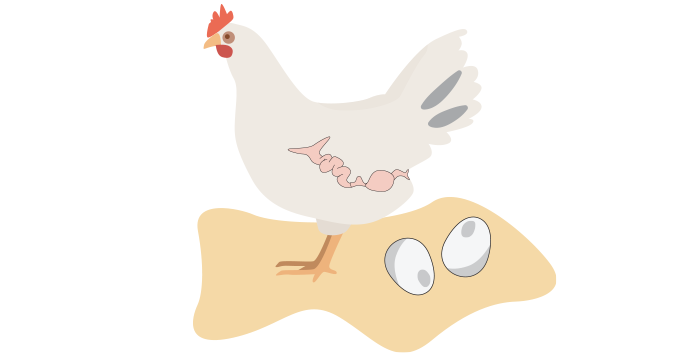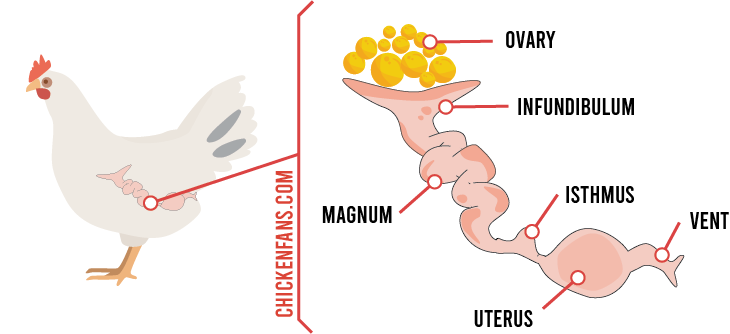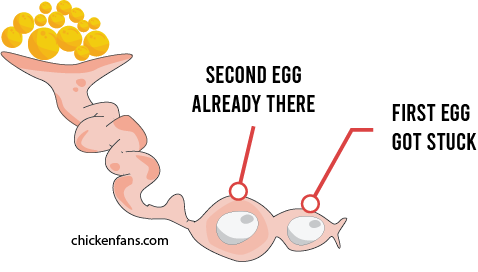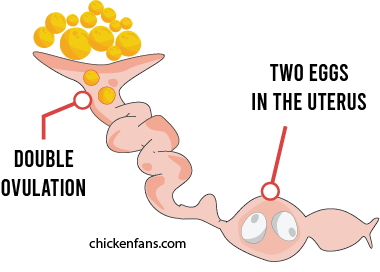Can Chickens Lay 2 Eggs a Day? (Explained)

You might have heard somebody bragging about a chicken laying two eggs a day. Or maybe you are wondering why you have more eggs than chickens today. Did you miss an egg yesterday?
Let’s find out and ask the million-dollar question.
Can chickens lay 2 eggs in one day?
Yes, chickens can sometimes lay two eggs in one day. It doesn’t happen often, but it’s more common than it used to be. Normally, it takes 24 hours to build a completely new egg in the chicken’s body, but now and then, a quirk in the process can produce a second egg.
To understand how this is possible, we need to know how egg formation works inside a chicken.
Let’s have a quick glance at the wonders of nature.
The Chicken’s Egg Factory
It takes about 24 hours for a laying hen to go from ovulation to laying an egg. The chicken’s body has a small factory to build eggs, the oviduct. Every egg goes through the same process one by one.
When a chick is one day old, it already has ten thousand mini eggs in its body, called oocysts. Some of these mini-eggs start to grow into yolks, a few at a time. Every laying hen has multiple yolks ready for egg production all the time.

When a yolk starts it travel to form an egg, it passes a couple of stages:
- the infundibulum catches a yolk and passes it to the magnum
- in the magnum, the egg white forms, taking about 3 hours
- in the isthmus, the egg is getting a protective membrane, which takes about an hour
- then in the uterus, the egg-shell is formed and gets its color; this takes about 20 hours
There is no way to ‘speed up’ this process. It is just how long it takes. There are no super-talented chickens that can build eggs twice as quickly.
So the question remains.
How can a chicken lay two eggs in one day?
There are three possible ways a chicken can lay two eggs within the span of 24 hours:
- if an egg gets stuck in the uterus until the next egg already arrives
- if the ovary releases two eggs simultaneously
- if the first egg takes a little longer to develop and the second egg ‘catches up’
There is something to say about all three of these scenarios.
Scenario 1: the first egg gets stuck
In the first scenario, the first egg goes through its normal building process but gets stuck in the uterus for multiple hours. This allows the second egg to build and catch up on the first egg.

It’s not that uncommon for a hen to postpone the egg-laying. Any stressful situation can cause egg retention.
Stress can occur in multiple situations, for example:
- when a chicken enters a new flock
- when a rooster is overly aggressive toward a hen
- in case there has been a predator attack
- when the chickens don’t have enough space
How do you know if you are in this scenario?
Since the first egg gets stuck, there won’t be an egg the day before the hen is laying two eggs in a single day. So when you see your chicken is suddenly laying two eggs a day, it’s usually after a pause day.
But what if the laying hen did not have a pause day at all? What if she produced an egg the day before?
Then we come to the second scenario.
Scenario 2: the ovary releases two yolks at the same time
In the second scenario, the ovary releases two eggs simultaneously. This starts the complete cycle with two yolks at the same time.
Usually, this results in a double-yolked egg. Double yolks are pretty common, especially with younger hens still maturing their reproductive systems. Their hormones are not completely balanced yet.

But in this case, the uterus builds two completely distinct shells around each yolk, resulting in the formation of two eggs at the same time. This process takes about 20 hours, and somehow these eggs need to stay completely apart without influencing each other, which is quite striking.
In 2019, Navara K. and Wrobel E. described how there is enough space in the uterus of a White Leghorn to host two eggs in a horizontal position. However, it’s still unclear how the two eggs would stay separated in this scenario.
This leaves us with the last possible scenario.
Scenario 3: the second egg catches up on the first egg
The egg formation takes about 24 hours in total. However, there is some variation in the timings of every step in the process. It’s not that a chicken has an internal stopwatch, and every egg is produced in exactly the same timebox.
It’s like driving in traffic. Sometimes you have all red lights, and it takes a little longer to reach your destination. But sometimes, you have all green lights, and things work out great.
If the first egg is produced at a standard rate and the second yolk is released quickly and goes through the oviduct as a ninja warrior hitting all record times, it might catch up some hours on the first egg. However, Navara K. and Wrobel E. describe this scenario as very unlikely.
Selective Breeding
More and more, people are reporting double-yolked eggs and chickens laying two eggs a day. Already in 1976, researchers reported an increase in double-yolked eggs for White Leghorns.
For decades, breeders have been selecting the best-performing egg-laying hens. Chickens that are genetically predisposed to release two yolks at the same time might have been favored over the others since they are producing more eggs. On the other hand, selective breeding also resulted in fewer abnormal eggs or laying patterns.
Due to obvious commercial interest, the poultry industry is very interested in selecting hens that can repeatedly lay more than one egg a day.
For now, it’s still a little bit of guessing why more chickens can lay two eggs daily. It’s also terribly difficult to investigate for researchers since double eggs are so infrequent. Navara K. and Wrobel E. described that they would have had to check 195 hens a day for double eggs during the experiment.
Wrap up
A chicken can lay two eggs in a single day. It’s not commonplace and certainly doesn’t happen every day. Mostly, a chicken only lays one egg per day or less.
There are no uber chickens or breeds that optimize the egg-building process. It’s rather the result of some abnormalities in the manufacturing process.
The most likely scenarios are:
- the first egg got stuck in the uterus, allowing the second egg to catch up. Egg retention can be the result of stress. In this case, the day before is an egg-pause day.
- the ovary releases two eggs simultaneously, and instead of a big double-yolked egg, two separate eggs are created in the uterus. Double yolks are common in young pullets that are still maturing their hormones.
So next time you find an extra egg, you might have stumbled across one of the quirks of mother nature. Just make sure your chickens are not in any stressful situations.























